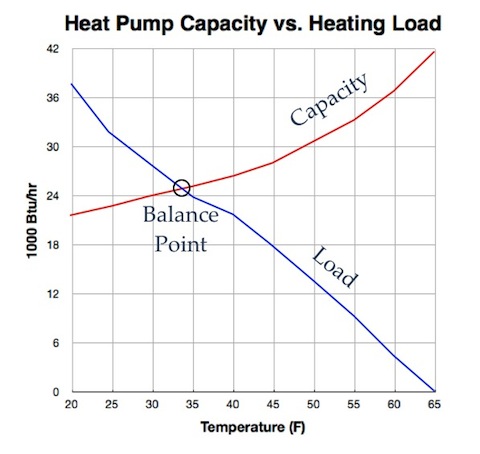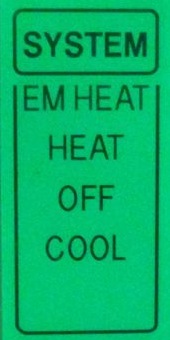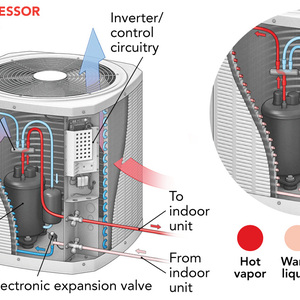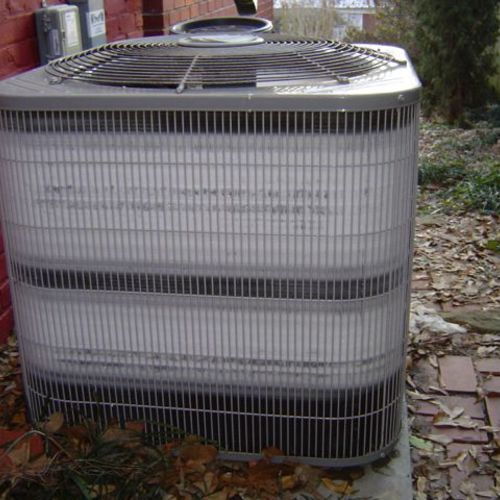
Since more people are using heat pumps these days, even in cold climates, let’s spell out the three different types of heat that conventional heat pumps provide. Why not? We’ve just recently covered the three main sources of home heating and then stepped back and looked another group of three sources of heat for high-performance homes (as enumerated by Skylar Swinford). Now let’s zoom in a bit on heat pumps.
1. Pumped heat
This is the heat you get when the compressor runs. The compressor is what drives the refrigerant through the phase-changing, heat-exchanging thermodynamic cycle that allows your heat pump to extract heat from the cold outdoor air and transfer it to your warm indoor air. This is possible because the Second Law of Thermodynamics says heat flows from warmer to cooler objects…and the refrigeration cycle makes the outdoor coil colder than the outdoor air.
This type of heat is abundantly available when it’s chilly but not real cold. As the outdoor temperature drops, so does the amount of heat available in the outdoor air. That in turn reduces the capacity of the heat pump. As long as the outdoors isn’t at absolute zero —and it’s never absolute zero anywhere — there’s still heat available. It just gets harder and harder to move it indoors.
Eventually, the amount of compressor heat available drops below the amount of heat needed inside the home. That’s when you need…
2. Supplementary heat
As stated above, the heating capacity of a heat pump drops as the outdoor temperature drops. At the same time, the heating load of the house increases. At some temperature, the capacity is just equal to the load, a temperature we call the balance point. Below that, the load is bigger than the capacity and you need some type of supplementary heat.

As I discussed in the three main sources of home heat article, the supplementary heat is typically provided by electric resistance heat (also called strip heat). But it’s not the only choice. You could pair a furnace with your heat pump and have what’s called a dual fuel system. Or you could put a hydronic coil in the air handler, which is really nice way to provide your supplementary heat.
3. Emergency heat
And then there’s that setting on your thermostat you may have noticed. Maybe you’ve even been told to set your thermostat to it whenever it’s cold outside.

Heat pump thermostats have a fourth mode (after heat, cool, and off) called emergency heat, which turns the compressor off and relies on the supplementary heat source for all of your heat. If, as many do, your heat pump uses strip heat as your supplementary heat, then your heating bills will go up, possibly way up. Don’t do that!
Emergency heat is aptly named. If your supplementary heat is provided by electric resistance, you should use that setting only when the heat pump is not working and you can’t get any pumped heat.
Now you know all about heat from heat pumps. Or at least the three types of heat provided by conventional heat pumps. I guess I should say something about mini-split heat pumps, but I’ve got to go get some breakfast now so that’ll have to wait.
Allison Bailes of Decatur, Georgia, is a speaker, writer, building science consultant, and the author of the Energy Vanguard Blog. You can follow him on Twitter at @EnergyVanguard.
Weekly Newsletter
Get building science and energy efficiency advice, plus special offers, in your inbox.















19 Comments
Heat Strips
Given the section on emergency heat, should the output capacity of the heat strips be such that they can provide 100% of the heat for a home at the 99% design temperature?
Secondly, are heat strips, when operating in supplementary mode, designed to have variable power output (meaning the voltage [Power = V^(2)/R] or current [Power = i^(2)*R] can be varied) so that it can meet the requirements of a home's heat load? Or is the power output constant and the duty cycle increases or decreases depending on the heating load?
Antonio,
Actually, ACCA Manual S recommends the emergency heat capacity for a heat pump should be able to meet 85% of the design heating load. But they also say emergency heat isn't required and that local code overrides that recommendation. Mini-split heat pumps often have no emergency or supplemental heat.
Regarding your second question, I don't know the answer to that. It comes down to controls designed for the system so it may be different for different brands of heat pumps. Maybe some of the HVAC folks will chime in here about that.
Obviously, the design idea is to make sure the balance point is much better than 34° and 25,000 btu/ hr. Those numbers are wretched for a decent house.
The balance point should, ideally, be below the design temperature.
I find this site really helpful and I've either learned a lot or done more research. Re heat pumps, I think it would be really helpful to state where a person is located, in regards to heat pumps. I'm in Calgary, Ab Canada and there isn't a lot of experience here. But enough.
Since mid Nov. I've been without a furnace bc I'm making a decision on a heat pump. It's been amazing to experience the really good insulation job that was done, and my own adaptation. I have a much better idea and imagination now, for if that back up heat is really necessary.
Still not sure if a bigger heat pump is a better idea without the back up, or a smaller one with the back up.
masincalgary
I am surprised that there is not more discussion about cold weather heat pumps. Most major manufacturers are now offering heat pumps that efficiently heat at temps as low as -13 degrees F. We need to electrify our heating systems and in most places throughout the USA, that is now doable in an efficient manner without fossil fuel or radiant strip electrical backup.
You are right. Here I am in cold Calgary. We have about four months of warm weather. And evenso, people use their furnaces, I'd say every month of the year. Except when there is a heat dome! I expect I may need to get the backup to meet code, but I may never need to use it. What I need to understand next, is how to do all of this without increasing the amp service to my home (because the utility will charge extreme amounts for digging up their lines). I'm presently looking at some kind of 'smart' electric efficiency sharing type of thing. It can't be smarter than my lap top, but it does cost quite a bit more!
My minisplits only require 240 volt, 15 amp circuits.
Typically a 15A circuit will only support a 12kbtu/hr minisplit. A typical house in Calgary will need several of those. Adding 40-50A of potential draw can easily push you outside of the service size you've got.
For demand calculation for sizing your service, you need to find the actual max power use of the units. The 15A is typically the MOCP, which is the max breaker size, this is usually much larger than the max draw of the unit.
Most 12k mini splits have a max draw of around 2kW, so only 8.3A. A 3 ton hyper heat Mitsubishi unit has a max draw around 22A.
You do have to watch for strip heaters, those can add a fair bit especially if the system is configured to run with both strip heater and HP at the same time.
With frequent forays below -30C and occasionally down to -40C, some kind of supplemental heat is inevitable. Three tons won't even come close To enough for most homes in Calgary, so I still think 40A isn't that far off.
At those temperatures, expect some heat pumps to shut off, leaving you with only resistance heat. Or a COP near 1.0, which has the same effect.
You might check out this article:
https://www.greenbuildingadvisor.com/article/does-your-electrification-project-require-a-service-upgrade
If you also check out the comments, there are several options for how to assess the need for a service upgrade. Smart controls are a great options, but you might find you don't even need that.
I spent the first 35 years of my life in Calgary. Furnace was definitely off for three months straight every year. If you improve your air sealing and insulation, that will help span more cool nights during the shoulder season when the average temp is above 15C. Calgary has the benefit of a lot of sunlight, even in winter. Passive solar makes a lot more sense there than SW Ontario, where it's common to not see the sun for two weeks at a time in the winter.
Jonathan, will you be having one installed?
yes, I have already had a few installed and am planning more. I am a GC.
For real emergencies, assuming you still have electric power, a cheapo plug-in standalone electrical resistance heater is an easy but not elegant solution.
Its unfortunate that consumers can mistakenly end up using resistance heating instead of more efficient heat pump heating if they don't understand the controls. Or if they don't understand the difference in heating efficiency of heat pumps vs. resistance heating (and what it does to their heating bills). Resistance heating is not as efficient as heat pump (2-3 times more efficient), but often the faulty perception is that electric heat is electric heat, doesn't matter if its resistance or heat pump heating.
Its also unfortunate that consumers believe that turning off your heat pump at night then cranking it up full blast when they get up in the morning, doesn't save money, it ends up costing more (unlike fossil fuel appliances). Heat pumps are not just "on-off" appliances on a thermostat, they are more efficient when running continuously at a lower rate. I keep getting arguments that if the heat pump is off, there's zero cost, so turn if off overnight to save money.
Consumers can conclude that heat pumps or any electric heating is expensive, when the problem is that they do not use them in the most efficient and effective manner.
My contractor has done a retrofit and installed a heat pump and he says that he doesn't use the back up even on the -30 days. I will likely need to get the back up heat to meet code. Robert, - an inelegant plug in stand along resistance heater is what? (like the ones I got through last winter with --a plug in oil heater? a little fake fire ? it's not going to tie into my ducting, but maybe that' fine). Am I understanding you? And yes, it's entirely different. I envisage turning everything off from May - Sept. which is a stretch for Calgary.
*** The hardest part is the sizing. I can look at the BTUs calculated on the Energuide's blower door test. Of course the contractor will do this and I'm glad he's not interested in over-sizing which is also an energy drain. But I want to understand how he arrives at his number. Any guidance here is appreciated.
Also, I'll either get a switch or a smart system to manage the -30 days without increasing the amps to the house (which would cost as much as installing a new ASHP or solar system, tripling my costs!). Any advice on those and keeping those costs low? I do plan on PVs hopefully next year.
Thank you! I like learning from a variety of sources. Makes me feel more confident. It's complicated stuff!
Yes I was referring to those small, cheap ($50 to $100), portable, resistance electric plug-in-the-wall standalone 1500 watt, 5kBTU heater for emergencies, or just to heat a room or small area temporarily. (Not something that you would connect to any central heating system.) So if your central heating system fails, you can wait for the repairs and have a source of heat (assuming you still have AC electric utility service working). They are simple to operate, portable, and throw off a good amount of heat quickly. Would be helpful if an unusually frigid weather pattern is too much for a heat pump to operate effectively. Would not meet code as a heating system for a home unless a number of them were built-in.
Small resistance (or radiant heating) units could be installed in a wall and connected through 115VAC to your electric service panel, and it could meet code for a home heating system (at least for that room). Built-in units are inexpensive ($100 to $500 for nicer ones). Not a good solution from an efficiency standpoint though (vs. heat pump), unless its only needed occasionally or for supplemental heat. These can work well for bedrooms for supplemental heat with a minisplit used the main source of heat in an open floor plan. I installed radiant electric ceiling units in bedrooms in the passive solar home I built in 1983, and they were used on about a third of winter nights in Colorado USA. Cheaper than having minisplit heads per bedroom, or ducted to several rooms.
Log in or create an account to post a comment.
Sign up Log in